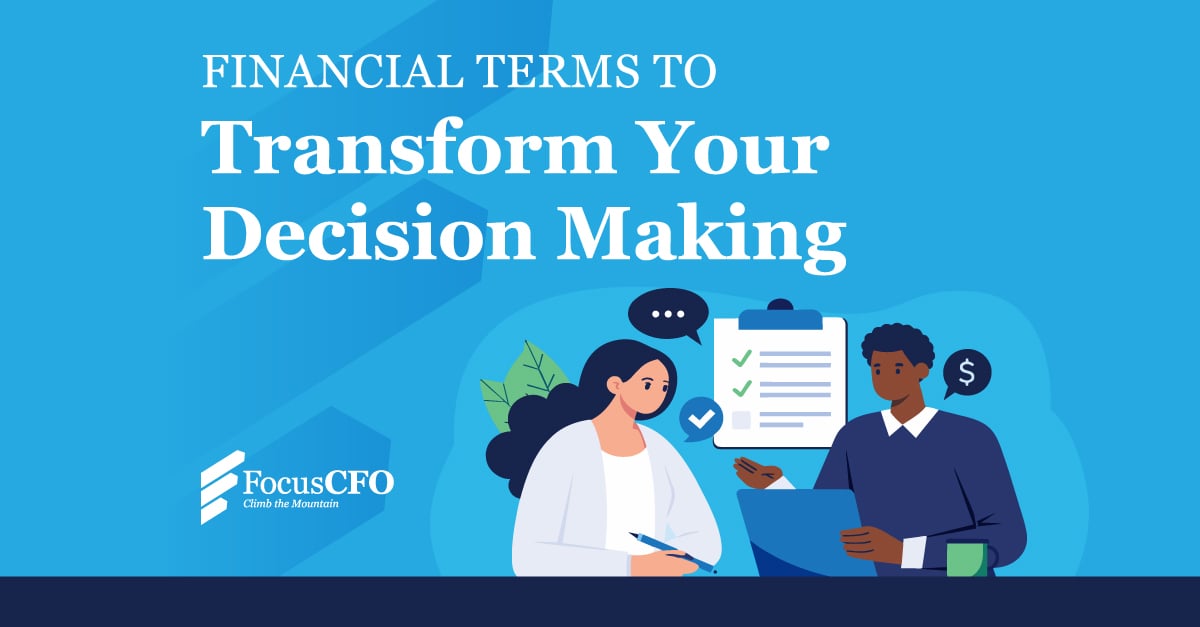The world of business finance comes with its own language – a sea of acronyms and jargon-heavy terminology that often leads to misunderstanding, overwhelm, and lost opportunities.
Why? Few business owners take the time to learn this language. They get so caught up in the day to day of running the business and so focused on surviving month over month that they neglect the deeper layer of knowledge that could drastically improve how they run their businesses and help them make faster, more confident decisions.
This guide breaks down some of the essential financial terms every entrepreneur should know.
Financial Terms Every Entrepreneur Should Know
EBITDA (Earnings Before Interest, Taxes, Depreciation, and Amortization)
EBITDA measures your business's operational performance without the noise of financing and accounting decisions. Think of it as a clear snapshot of how well your core business is doing.
Why it matters: EBITDA is widely used by management, investors, and lenders to assess profitability and compare companies across industries. In addition, investors and lenders often look at EBITDA as a proxy for cash flow. If your EBITDA is strong but cash is always tight, it’s time to dig into your cash flow (more on that next).
Cash Flow vs. Profit
These two terms are often confused but can make or break your business: Profit is what’s left after expenses. Cash flow is the actual movement of money in and out of your business.
Why they matter: A profitable business with poor cash flow can run out of money and fail. A business with positive cash flow but no profit may not be viable long-term. Smart businesses watch both, keeping an eye on profit to maximize value and grow and attract investors, and monitoring cash flow to stay alive and operate smoothly.
Runway & Burn Rate
These terms are crucial for startups and growing businesses that aren’t yet cash-flow positive.
Burn rate is how much money you’re spending monthly. A high burn rate means your business is spending a lot of cash quickly. A low burn rate means you’re spending more cautiously or efficiently.
Runway is how many months you can operate before running out of cash. It tells you how long you have to become profitable or raise more capital, and it helps you prioritize actions like cutting costs, pivoting the business model, or accelerating revenue growth.
Why they matter:Think of it like this: Burn rate is your speed, and runway is your distance left to travel. Both are essential for navigating the business toward profitability or a successful funding round.
Gross Margin vs. Net Margin
Gross margin is the percentage of revenue left after subtracting the cost of goods sold (COGS). It reflects how efficiently a company produces or sources what it sells and helps guide pricing decisions. High gross margins often indicate strong pricing power or cost efficiency.
Net margin, on the other hand, is the percentage of revenue that remains after all expenses are deducted — including overhead, interest, and taxes. It reflects the company’s overall profitability and operational efficiency, and it plays a critical role in assessing long-term sustainability, investor returns, and business valuation.
Why they matter: Gross and net margins reveal different layers of a company’s financial performance. Gross margin shows product-level profitability, while net margin shows the bottom-line efficiency of the entire operation. Together, they offer a clear view of financial health.
CAPEX vs. OPEX
Distinguishing between capital expenditures (CAPEX) and operating expenses (OPEX) is more than an accounting formality—it affects your taxes, cash flow, and financial reports.
CAPEX (Capital Expenditures)
Capital expenditures involve spending on assets that provide long-term value. These expenditures are major, one-time or infrequent investments that benefit the business over several years and could include buying a delivery van, installing new equipment, and renovating buildings. Capital expenditures are capitalized and depreciated over time, meaning they do not immediately hit your profit-and-loss statement.
Why it matters: CAPEX matters because it reflects a company's vision for the future, affects financial stability, and plays a critical role in both short-term planning and long-term value creation.
OPEX (Operating Expenses)
OPEX consists of the day-to-day expenses necessary to run your business. Examples of these expenses include rent and marketing software subscriptions, and they are fully expensed in the year they are incurred, meaning they show up directly on your profit-and-loss statement.
Why it matters: Managing OPEX effectively is crucial for profitability, efficiency, and sustainability: It directly reduces operating profit. High or poorly managed OPEX may indicate inefficiency or bloat in your business, and it affects cash flow and can lead to cash shortages, even if revenue is strong.
Using ROI to Evaluate Business Decisions
Return on investment (ROI) is your best tool for deciding whether a business expense is worth it, allowing businesses to measure how effectively it’s using its money to generate profit. To calculate percent ROI, you divide the net profit generated by the investment by the total cost of the investment and multiply by 100.
Why it matters: ROI informs decision-making, helping businesses compare multiple investment opportunities and design effective strategies. It measures the efficiency of your business, allows companies to prioritize where to spend money, and tracks performance over time.
Knowledge Is Power
The key takeaway for business owners: Mastering a few financial fundamentals can unlock better decision-making and long-term growth for your venture. You don’t have to become a finance expert. You just need a baseline understanding to ensure you are heading in the right direction.
Want to take the next step?
Download our free Finance 101 guide for small businesses.
Looking for strategic financial leadership? Contact us today for a complimentary consultation.







